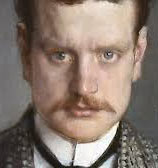
Johan Julius Christian Sibelius (1865-1957) was a Finnish composer and violinist of the late Romantic and early-modern periods. He is widely recognized as his country's greatest composer and, through his music, is often credited with having helped Finland to develop a national identity during its struggle for independence from Russia.
The core of his oeuvre is his set of seven symphonies which, like his other major works, continue to be performed and recorded in his home country and internationally. Throughout his career, the composer found inspiration in nature and Nordic mythology, especially the heroic legends of the national epic, the Kalevala.
Finlandia, Op. 26, is a tone poem by the Finnish composer Jean Sibelius. The piece was composed for the Press Celebrations of 1899, a covert protest against increasing censorship from the Russian Empire, and was the last of seven pieces performed as an accompaniment to a tableau depicting episodes from Finnish history.
In order to avoid Russian censorship, Finlandia had to be performed under alternative names at various musical concerts. Titles under which the piece masqueraded were numerous—famous examples include Happy Feelings at the awakening of Finnish Spring, and A Scandinavian Choral March. Most of the symphonic piece is taken up with rousing and turbulent music, evoking the national struggle of the Finnish people. Towards the end, a calm comes over the orchestra, and the serenely melodic Finlandia Hymn is heard. Often incorrectly cited as a traditional folk melody, the Hymn section is of Sibelius's own creation.
The stand-alone hymn version, with words written in 1941 by Veikko Antero Koskenniemi, is one of the most important national songs of Finland.
With different words, it is also sung as a church hymn (Be Still, My Soul / This Is My Song). Most protestant churches identify "Finlandia" as just the hymn portion of the orchestral version.
This beloved hymn that had been excerpted from a symphonic work, is now returned to its original context.
Today, we utilize the full orchestra to accompany the congregation singing the 2-verse hymn text "This Is My Song." Because of time limitations, the orchestra begins about 1/3 the way thru the original version, and the congregation joins singing: Verse 1 with the original woodwinds scoring, and Verse 2 with strings (later adding everyone). The orchestra continues to the rousing end, accompanied by congregation goosebumps.

The orchestra has some turbulent moments leading up to the famous main theme of Finlandia that comprises the hymn melody.

